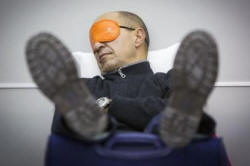|
Applying electrical current to the brain, according to a
study published online in Nature Neuroscience, induces "lucid
dreaming," in which the dreamer is aware that he is dreaming and
can often gain control of the ongoing plot.
The findings are the first to show that inducing brain waves of
a specific frequency produces lucid dreaming.
For the study, scientists led by psychologist Ursula Voss of
J.W. Goethe-University in Frankfurt, Germany, built on lab
studies in which research volunteers in the REM (rapid-eye
movement) stage of sleep experienced a lucid dream, as they
reported when they awoke. Electroencephalograms showed that
those dreams were accompanied by telltale electrical activity
called gamma waves.
Those brain-waves are related to executive functions such as
higher-order thinking, as well as awareness of one's mental
state. But they are almost unheard of in REM sleep.
Voss and her colleagues therefore asked, if gamma waves occur
naturally during lucid dreaming, what would happen if they
induced a current with the same frequency as gamma waves in
dreaming brains?
When they did, via electrodes on the scalp in a technique called
transcranial alternating current stimulation (tACS), the 27
volunteers reported that they were aware that they were
dreaming. The volunteers were also able to control the dream
plot by, say, throwing some clothes on their dream self before
going to work. They also felt as if their dream self was a third
party whom they were merely observing.
Voss does not foresee a commercial market in lucid-dreaming
machines. Devices currently sold "do not work well," she said in
an interview, and those that deliver electrical stimulation to
the brain, like the one in her study, "should always be
monitored by a physician."
But if the results hold up, the technique might help people
suffering from post-traumatic stress disorder, who often have
terrifying dreams in which they re-play the traumatic
experience. If they can dream lucidly, they might be able to
bring about a different outcome, such as turning down a
different street than the one with the roadside bomb or ducking
into a restaurant before the rapist attacks them.
"By learning how to control the dream and distance oneself from
the dream," Voss said, PTSD patients could reduce the emotional
impact and begin to recover.
(Reporting by Sharon Begley; Editing by Dan Grebler)
[© 2014 Thomson Reuters. All rights
reserved.] Copyright 2014 Reuters. All rights reserved. This material may not be published,
broadcast, rewritten or redistributed.

|
|


 To
Sleep, Perchance To Control Your Dreams
To
Sleep, Perchance To Control Your Dreams

